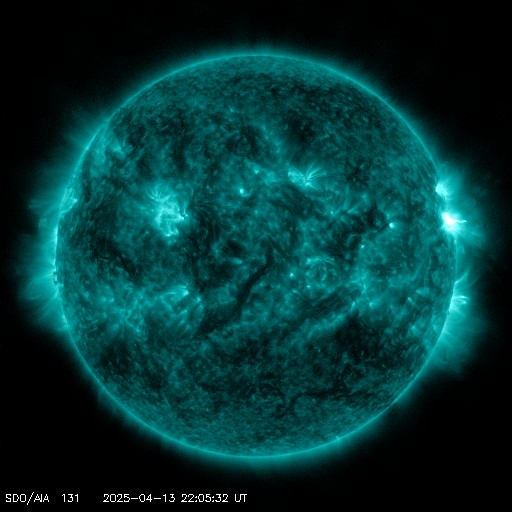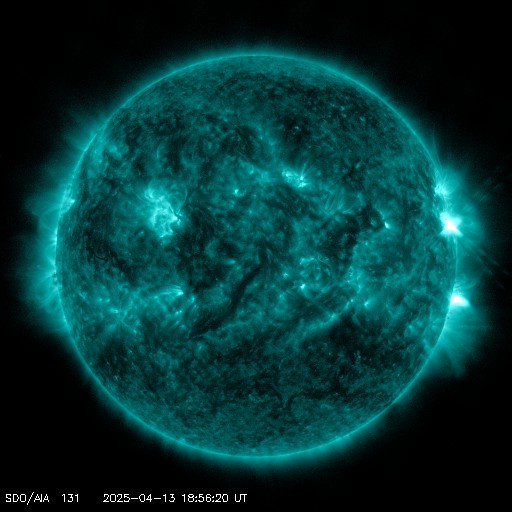Viewing archive of Saturday, 1 February 2014
Daily bulletin on solar and geomagnetic activity from the SIDC
Issued: 2014 Feb 01 1231 UTC
SIDC Forecast
Solar flares
Active (M-class flares expected, probability >=50%)
Geomagnetism
Active conditions expected (A>=20 or K=4)
Solar protons
Quiet
| 10cm flux | Ap | |
|---|---|---|
| 01 Feb 2014 | 168 | 005 |
| 02 Feb 2014 | 170 | 021 |
| 03 Feb 2014 | 172 | 003 |
Bulletin
Numerous C- and 3 M-class flares were recorded over the last 24 hours, mostly originating from NOAA 1967. This region has three magnetic delta structures: two near the main spot, and one near the top of the region. The latter was the location of the strongest flare this period (M3 peaking at 07:23UT). One M-flare had NOAA 1968 as its source (M1 peaking at 15:42UT), which has developed more small spots of opposite polarity in its interior. This M1-flare was associated to a partial halo CME with a plane- of-sky speed of 460 km/s. The bulk of the CME was directed to the northeast. The x-ray background has been all day above the C1-level. Active conditions are expected to continue, with a chance on an X-class flare. Solar wind speed has been varying between 300 and 350 km/s and Bz fluctuating between -3 and +3 nT. Geomagnetic conditions were quiet. For the next 24 hours, active geomagnetic conditions with a slight chance on minor storm levels are expected, in particular due to the arrival of the M6 CME (30 January) which is currently foreseen for the morning of 2 February. On 4 February, Earth may receive a glancing blow from the partial halo CME that originated in NOAA 1968 (31 January).
Today's estimated international sunspot number (ISN): 065, based on 05 stations.Solar indices for 31 Jan 2014
| Wolf number Catania | /// |
| 10cm solar flux | 166 |
| AK Chambon La Forêt | 003 |
| AK Wingst | 001 |
| Estimated Ap | 001 |
| Estimated international sunspot number | /// - Based on /// stations |
Noticeable events summary
| Day | Begin | Max | End | Loc | Strength | OP | 10cm | Catania/NOAA | Radio burst types |
|---|---|---|---|---|---|---|---|---|---|
| 31 | 1532 | 1542 | 1553 | ---- | M1.1 | 27/1968 | |||
| 01 | 0119 | 0125 | 0138 | S11E26 | M1.0 | 1F | 28/1967 | ||
| 01 | 0714 | 0723 | 0736 | S11E23 | M3.0 | 1B | 28/1967 | VI/2 |
Provided by the Solar Influences Data analysis Center© - SIDC - Processed by SpaceWeatherLive
All times in UTC
Current data suggests there is a slight possibility for aurora to appear at the following high latitude regions in the near future
NuukReykjavik
Latest news
Latest forum messages
Support SpaceWeatherLive.com!
A lot of people come to SpaceWeatherLive to follow the Sun's activity or if there is aurora to be seen, but with more traffic comes higher server costs. Consider a donation if you enjoy SpaceWeatherLive so we can keep the website online!

Latest alerts
Sunday, 13 April 2025
22:21 UTC - Solar flare
Moderate M1.66 flare from sunspot region 4055
22:03 UTC - Radio Blackout
Minor R1 radio blackout in progress (≥M1 - current: M1.01)
20:48 UTC - Hemispheric Power Index
The OVATION model predicts the Hemispheric Power Index to reach 50GW at 21:39 UTC
19:09 UTC - Solar flare
Moderate M3.24 flare from sunspot region 4055
18:51 UTC - Radio Blackout
Minor R1 radio blackout in progress (≥M1 - current: M1.07)
Space weather facts
| Last X-flare | 2025/03/28 | X1.1 |
| Last M-flare | 2025/04/13 | M1.6 |
| Last geomagnetic storm | 2025/04/06 | Kp5 (G1) |
| Spotless days | |
|---|---|
| Last spotless day | 2022/06/08 |
| Monthly mean Sunspot Number | |
|---|---|
| March 2025 | 134.2 -20.4 |
| April 2025 | 136.4 +2.2 |
| Last 30 days | 134.2 -8.9 |




